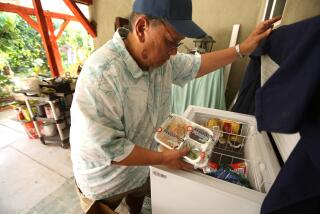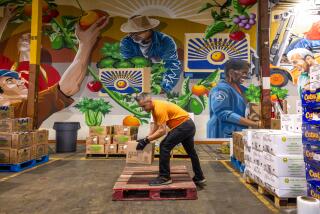Holiday Donations in Short Supply for Those Seeking Aid : Giving: Agencies that provide food and toys say need is greater, but stocks are low this Christmas.
- Share via
Economists measure a recession in terms of consumer spending and unemployment rates, but for Ramona Fuentes last week the arithmetic of hardship came down to the price of turkeys.
A community educator for El Centro de Amistad in Canoga Park, Fuentes was trying to buy 150 Christmas dinner turkeys for impoverished residents of the west San Fernando Valley but only $500 had been donated to pay for them.
“The cheapest we found was 69 cents a pound and even the big warehouses wouldn’t cut their prices below that,” she said on Tuesday. “What do we do? Buy only 50 turkeys? But then how do we decide who gets them?”
In previous years, the community mental health counseling agency had provided more than 600 families from across the Valley with a good holiday meal, a few toys for the kids and warm clothing. This year, fearing a drop in donations, the agency committed itself to giving gift baskets to only 210 families. Sixty of the families’ needs have been taken care of by individuals or groups who agreed to sponsor them.
But supplying the needs of even the smaller number proved difficult, as corporations and individuals who were regular donors from past years said that the recession prevented them from chipping in. By Thursday, El Centro de Amistad had to take $600 out its own budget to cover the shortage of donations, which means that services may have to be reduced later.
The dilemma faced by Fuentes, and the decision of the agency to spend operating funds to help make Christmas bright, are common this year as Christmas, 1991, pencils out to be the tightest one in many years for charities in the San Fernando, Santa Clarita and Antelope valleys.
With the ranks of those in need swollen by the newly unemployed, the demand for a few toys or food is rising far more quickly than the supply. Layoffs of workers in manufacturing, particularly by aerospace-related companies, construction and other sectors of the local economy are causing hardship to spread. In addition, many people who used to hire day laborers, gardeners and house cleaners are themselves unemployed, pushing the unskilled and the newly arrived into poverty.
Fuentes said that those families her agency turned away were referred to other charitable organizations. But, she said, other agencies are scaling back, making it hard to find help for all who need it.
The North Angeles region of the United Way, which distributes money to 61 member agencies in Burbank, Glendale and the San Fernando and Santa Clarita valleys, increased the fund-raising goal for its current campaign by 2.5% from last year to just over $4 million. But, spokeswoman Barbara Bickel said: “Even if we make our goal, the needs in our communities have grown tremendously, so more money than ever before is necessary.”
She said 70% of the companies in the region that usually make corporate donations to the United Way are making cutbacks in their operations and about 7% have closed or are about to. “Our hope is to make our goal with the addition of new companies joining the United Way family,” she said.
The situation is similar with the Greater Los Angeles area chapter of United Way, which fell $12 million short of its fund-raising goal last year and pared its expectations even further in its current drive.
Those trends--of rising need and falling support--have become even more apparent as the Christmas holiday approaches.
For example:
* The Los Angeles County Community Services Center in Newhall last week was 1,200 toys short of its goal to provide gifts for 3,200 needy children. Donations of food and money to feed more than 500 families also were under what had been expected and officials said they need $1,000 more to buy turkeys.
* Donations to Toys for Tots, run by the U.S. Marine Corps Reserve, were lagging about 25% behind demand in Southern California. About 600 charities and groups in the area that rely on the program have requested 480,000 toys for gifts this year, up 63% from a year ago. The program’s Encino operation had requests for 28,000 toys from 40 agencies, and workers were anticipating falling several thousand gifts short.
* The Salvation Army unit serving the Antelope Valley will divert money from other services it provides in order to purchase food and toys for more than 1,000 families, because donations are down.
“We will buy an awful lot of groceries, as much as we need,” said Capt. Debbie Hood, who is based in Lancaster. The same goes for toys. “We’ll make sure there is enough. We’re not letting any child age 14 and under to go without a gift.”
Hood said the unit has already spent $6,000 more than budgeted for food for the holidays. And that means the agency’s resources to serve the community’s needs the rest of the year will be stretched.
To be sure, there are bright spots amid the gloom:
Employees of Silgan Containers, a Burbank company, decided to forgo the annual free holiday turkey, poinsettia and candy from their employer in favor of having $3,000 donated to three agencies that assist the poor, homeless or mentally retarded.
First Western Health Corp. of Van Nuys donated 375 toys to the Salvation Army instead of giving Christmas gifts to their clients, who are workers compensation attorneys.
Among the families that picked up toys from the Salvation Army last week were Antonio and Elisa Barocio. Antonio Barocio had installed security bars until he lost his job more than a year earlier. But Elisa Barocio said children don’t understand that financial straits can make Christmas gifts impossible, she said.
The Barocios’ two eldest children, Antonio Jr., 5, and David, 4, had asked Santa Claus for a Nintendo game and a bicycle. They won’t get what they asked for, Elisa Barocio said, but “I’m happy I can at least get something for them underneath the tree.”
Also on a positive note, officials of several agencies said that this year there is no shortage of volunteers, who collect, sort, wrap and deliver gifts and food baskets.
One such volunteer is Norman Steinberg, a 67-year-old retiree who exhorts stores and wholesalers to donate food and other goods to Cornerstone, a service center for mentally ill homeless people in downtown Van Nuys.
Steinberg gathers food for the center each week, but he’s also helped assemble a variety of toiletries and other personal items to be handed out at Christmas. “I’m trying to get anything I can get my hands on,” he said.
Along with other donations of T-shirts, socks, shaving cream and food from other sources, Steinberg’s work will make it possible for the center’s clients to “have a good Christmas,” said Ludelia Cowan, Cornerstone’s program coordinator.
But the outlook is less upbeat at most charities and agencies.
Marianne Haver-Hill, executive director of the Pacoima-based charity known as MEND (Meet Each Need with Dignity), said financial donations are running 13% behind last fall’s level and gifts of canned and dry foods for food boxes for 1,200 families are also off. She said the person who coordinated the Christmas drive for the charity contacted several hundred groups, schools and businesses that have donated in the past. The coordinator found, however, that many of the businesses no longer exist.
“We’ll just have to dig deeper” into the agency’s budget, Haver-Hill said. “If we get less in donations at this time of year, it will just impact what’s going to happen later on.”
She also worries that donations will not rebound in January, when, typically, the demand for food donations is as great as in December.
Lt. James Halverson of the Salvation Army unit in the San Fernando Valley said the agency served 1,700 families last year and will give toys to nearly 2,500 families this year, either before Christmas or at a party with Santa on Christmas Day. But others who came to the agency too late had to be turned away.
“We’re now telling people . . . there’s nothing we can do, because we’re really overrun,” Halverson said.
* CHARITY: Needs grow, but funds decrease. B1
More to Read
Sign up for Essential California
The most important California stories and recommendations in your inbox every morning.
You may occasionally receive promotional content from the Los Angeles Times.













